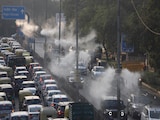A few government schools in Delhi have always been in more demand compared to others. Reasons have varied from diligent principals and better infrastructure to perhaps good board results. As a result, parents usually seek admission only to the schools perceived as good, thus leading to an enrollment imbalance in institutions within the same locality.
Complex Admission Process
In early 2016, when the Aam Aadmi Party (AAP) government had just taken charge, a few parents complained to Deputy Chief Minister Manish Sisodia about gaps in the admission process. It was then that the issue of admissions was first brought to the notice, and Sisodia intervened to streamline the complex admission process.
Thousands of children have been taking admissions to Delhi's government schools since 2019. Another encouraging observation has been the parent turnout to seek admission. This has been in contrast with other Indian states, where government schools are being closed and the trust of parents in government schools has been declining.
Education has always been the first priority of the Arvind Kejriwal government, and hence, the focus on simplifying and improving the admission process. While a lot of work was undertaken and is ongoing, there have been a few noteworthy reforms.
Introduction of Clusters
Government schools in Delhi were already being categorized based on Zone, District, and Region. Later in 2016, clusters were created by the Education Department. Simply put, a cluster is an aggregation of a few nearby schools based on their demography. A committee was also constituted at each cluster and zone level, consisting of a few School Management Committee (SMC) members and heads of schools.
Now, when a parent applies for admission to classes 6 to 12 in any government school, the application form goes to their particular cluster or zonal committee. These committees then allocate the school based on parameters like vacant seats, distance from students' homes, etc. This step has eradicated two problems: dependency on a handful of schools, and denial of admission without giving any reason.
The department also decided to turn the admission process online. Students who want admission to classes 6 to 12 must apply online. Schools also set up help desks for assistance. This step has relaxed the admission process at school. Moreover, the department is saving tons of paper.
SMC Members In Admission Committees
In 2016, when committees were constituted, another major decision was to have SMC members on these panels. This step has shown great results as it makes the SMC feel empowered and accords to it a moral responsibility to admit all children. Even in 2020, during the first Covid-19 wave, SMC members were going door to door to create awareness and identify children who were out of school.
The above three steps have played a crucial role in making the admission process in Delhi's government schools robust, transparent and inclusive. Other states must learn from these reforms and their impeccable execution at the grassroots.
(The author is Member of Education Task Force, Office of Education Minister, NCT Delhi)
Disclaimer: These are the personal opinions of the author















